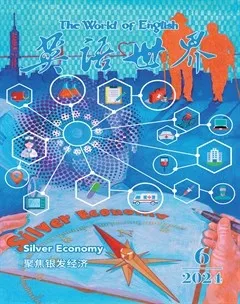Why Some Animals Evolved to Sacrifice Themselves动物为何舍身繁衍
贾森·比特尔/文 陈晓璐/译
A male musk ox can weigh up to 800 pounds and charge at speeds over 30 miles per hour. During the breeding season, these shaggy1, Arctic Circle behemoths crash into each other face-first and then stab their opponents with their huge, sharp horns.
一头雄性麝牛体重可达800磅,奔跑速度超过30英里/小时。在繁殖季节,这些体毛粗长的北极圈巨兽会脸对脸地猛撞在一起,然后用它们巨大而锋利的角刺向对手。
Whats more, over the course of their 10- to 12-year life-spans, a single male musk ox might rack up2 something like 2,100 hits to the head.
更夸张的是,在它们10到12年的寿命中,一头雄性麝牛的头部可能会受到2100次撞击。
“People have always just assumed that animals that headbutt3, like musk oxen and bighorn sheep, are somehow immune to head injuries,” says Nicole Ackermans, a neuroscientist at the Icahn School of Medicine at Mount Sinai in New York. “Like they have magical horns, or something.”
纽约芒特西奈伊坎医学院的神经科学家妮科尔·阿克曼斯说:“人们总是想当然地认为,像麝牛和大角羊这样用头撞击的动物,其头部怎么也不容易受伤,就好像它们的角有魔力似的。”
Ackermans and her colleagues acquired the brains of musk oxen and bighorn sheep from a combination of field expeditions, donations from subsistence hunters, and captive research herds.
阿克曼斯和她的同事们通过实地考察、自给猎人捐赠和研究用圈养兽群,获得了麝牛和大角羊的大脑。
“We found a specific pattern in all of our specimens that looked really similar to early chronic brain trauma in a human,” says Ackermans, who led a recent paper on the findings, published in the journal Acta Neuropathologica.
阿克曼斯说:“我们在所有样本中发现了一种明确的规律,看起来与人类早期慢性脑外伤非常相似。”她最近在《神经病理学学报》上发表了一篇关于这些调研结果的论文。
Its evidence that evolution can lead a species down surprisingly self-destructive paths. And in this regard, the musk oxen are far from alone.
这证明了进化可以引导某类物种步入令人惊讶的自我毁灭之路。在这方面,麝牛绝不是唯一的案例。
‘Just dont die
“不死即可”
For their research, Ackermans and her colleagues stained the brains of three musk oxen and four bighorn sheep with biomarkers. These chemicals can illuminate patterns of traumatic brain injury commonly associated with human conditions, such as Alzheimers disease and chronic traumatic encephal-opathy, or CTE. In this case, the scientists were searching specifically for something known as the tau protein.
在研究中,阿克曼斯和她的同事們用生物标志物对三只麝牛和四只大角羊的大脑进行染色。这些化学物质可以标亮人类常发生的创伤性脑损伤模式,如阿尔茨海默病和慢性创伤性脑病。就这项研究而言,科学家们专门寻找一种被称为微管相关蛋白的东西。
“When your neurons get damaged, whether it be through aging, genetic problems, or mechanical impact, they get ripped, and this protein breaks down and forms into clumps,” Ackermans explains. “And if you see them in specific patterns, thats how you can tell whether its just a normal brain, or aging, or Alzheimers, or potentially trauma.”
阿克曼斯解释说:“无论是由于衰老、遗传问题还是机械冲击,只要你的神经元受损,它们都会被撕裂,然后这种微管相关蛋白就会分解并形成团块。如果你看到这些蛋白以特定的模式出现,你就能判断出一个大脑当前的情况,是正常的还是老化的、是患有阿尔茨海默病还是受到潜在创伤的。”
Unfortunately, the biomarker method didnt work as well on the sheep brains, though they did show signs of tau buildup.
不幸的是,尽管生物标志物确实显示出微管相关蛋白积聚的迹象,但这一方法在大角羊的大脑中并不奏效。
“Each year, a musk ox will headbutt many times, but if they reproduce even once successfully, thats kind of all you need,” she says. “The thing thats encouraged, evolutionarily, is just dont die.”
她说:“一头麝牛每年会撞头多次,但它们只要成功繁殖一次,就足够了。从进化的角度来看,它们信奉的是不死就行。”
It probably helps that male musk oxen live less than 15 years and females live 15 to 23 years, she says. So even if tau proteins are building up throughout the animals lives, they may never accumulate to a point where they can cause conditions such as Alzheimers or other dementias.
她说,雄性麝牛的寿命不到15年,而雌性麝牛的寿命为15至23年,这大概算是幸事。这样一来,即使微管相关蛋白在它们的一生中不断积累,其累积量也可能永远不会多到导致阿尔茨海默病或其他痴呆症的程度。
And even if they did develop those conditions, who would know? “Theres no behavioral scale for musk ox. So we cant say that theyre not feeling a little forgetful,” she says.
或者即使这些动物真的患上了这些疾病,谁又会知道呢?她说:“我们没有为麝牛制定行为量表,所以无法断定它们没有感到有些健忘。”
Mating to death
交配至死
Small and carnivorous, antechinuses are a genus4 native to mainland Australia and Tasmania. In recent years, theyve made headlines for the way the males practice semelparity—or a single burst of reproductive output, followed by programmed death. Antechinus females can live two to three years or more. But the males rarely last more than 11 months.
小型食肉動物袋鼩是澳大利亚大陆和塔斯马尼亚的本土物种。近年来,雄性袋鼩的单次繁殖(即繁殖一次,然后按预设过程死亡)屡屡见诸报端。雌性袋鼩可以活两到三年或更长时间,但雄性很少能活过11个月。
“They have a very frantic mating season,” says Fisher. Breeding bouts5 can last 12 to 14 hours, and afterward each male will try to mate with as many other females as he can—which leads to his demise.
费舍尔说:“它们会经历一个非常疯狂的交配季。”单次交配可持续12至14个小时,而且每只雄性都会设法与尽可能多的雌性交配——这导致了它的死亡。
Self-destructive insects
自我毁灭的昆虫
In large, social insect colonies, a similar but slightly different dynamic plays out.
在大型的群居昆虫群体中,类似但略有不同的模式也在上演。
When a European honeybee stings a soft-skinned attacker, such as a bear, it dies when its stinger6 lodges7 in the victims skin. An exploding ant may rip its abdomen in two while defending its nest from attackers. And in some termite species, elderly workers can turn themselves into suicide bombers.
欧洲蜜蜂蜇伤皮肤柔软的攻击者(比如熊)时,会因为它的刺卡入受害者的皮肤而死亡。爆炸蚂蚁在保护自己的巢穴免遭攻击时,可能会把自己的腹部裂成两半。在某些白蚁种类中,老年工蚁会把自己变成自杀式炸弹。
But how does killing oneself make sense, evolutionarily speaking?
但从进化的角度来看,自杀有什么意义呢?
“Easy,” says Thomas Seeley, a biologist at Cornell University and author of The Lives of Bees, in an email. “Workers achieve genetic (evolutionary) success not by reproducing themselves, but helping their mother, the colonys queen, do so.”
康奈尔大学的生物学家、《蜜蜂的生活》一书的作者托马斯·西利在一封电子邮件中说:“很简单,工蜂获得遗传(进化)上的成功不是通过自己繁殖,而是帮助它们的母亲,也就是蜂群的蚁后繁殖。”
“One form of this help is colony defense,” he explains.
“这类帮助的一种形式是群体防御。”他解释说。
“Some researchers call this a ‘superorganism,” says Alice Laciny, an entomologist who works on exploding ants at the Natural History Museum Vienna, in an email. “So an ant colony or bee hive is more like one large animal, with the queen representing the reproductive organs. The minor workers are numerous and only need small amounts of resources to rear, so they are similar to the bodys cells in a way.”
在维也纳自然历史博物馆研究爆炸蚂蚁的昆虫学家爱丽丝·拉齐尼在电子邮件中说:“一些研究人员称之为‘超级有机体。就是说,蚁群或蜂巢更像是一个大型动物,蚁后代表生殖器官。小工蚁数量众多,只需要少量的资源来饲养,所以它们在某种程度上类似于身体的细胞。”
A mothers ultimate sacrifice
一个母亲的终极牺牲
Another form of sacrifice in the animal kingdom is the lengths to which some mothers will go to give their young a fighting chance.
动物王国的另一种牺牲形式是一些母亲为了给孩子一个生存的机会而牺牲自我。
After theyre born, some species of legless amphibians known as caecilians literally eat their mothers top layer of skin as a first meal. And African social spiders take this one step further, with some females allowing their young to practice matriphagy—or the killing and eating of their own mother.
一些被稱为蚓螈的无腿两栖动物会在出生后,把母亲最外层的皮肤当作第一餐。而非洲的群居蜘蛛则更进一步,它们的雌性蜘蛛允许其后代噬母——即杀死并吃掉自己的母亲。
Giant Pacific octopuses may be the ultimate self-sacrificing mothers. Females can hold vigil over their eggs for an incredible four years—during which time they dont even eat.
太平洋巨型章鱼可能是最终极的自我牺牲型母亲。雌性可以守护它们的卵长达难以置信的四年——在此期间它们甚至不吃任何东西。
“Inevitably, the females deplete their entire body reserves and die while guarding the eggs,” says Fisher.
“不可避免的是,雌性会耗尽它们的整个身体储备,在守护卵的过程中死去。”费舍尔说。
“You do feel sorry for them, but thats how a lot of species get the best offspring success in the next generation.”
“它们确实让人感到难过,但这就是许多物种繁衍后代取得最大成功的途径。”
1 shaggy(毛发)粗长而蓬乱的。 2 rack sth up累积;聚集。 3 headbutt用头撞(某人的头或脸)。
4 genus(动植物的)属。
5 bout(某活动的)一段,一阵,一场。 6 stinger(昆虫或动物的)刺,蜇刺,蜇针。 7 lodge(被)固定;卡住。
——水芹主要害虫识别与为害症状

